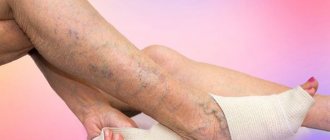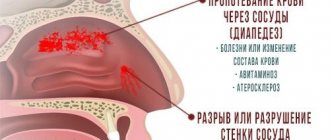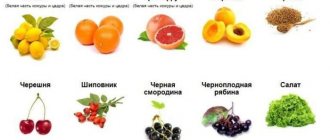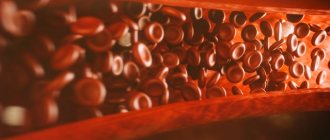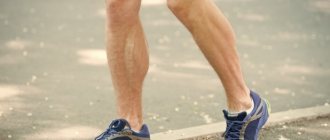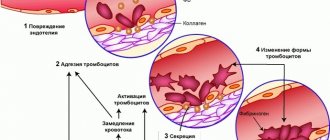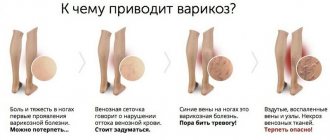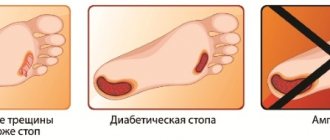Indications for use
Vitamins for strengthening blood vessels and improving their functioning are recommended for prevention purposes, as well as as part of any treatment regimen for the cardiovascular system.
Prevention
Its goal is to reduce the possibility of the disease occurring, so the use of minerals and vitamins in this case is indicated for people at risk of developing vascular pathology, as well as healthy people who want to prolong the normal functioning of their arteries and veins.
It is recommended to take the drugs as an additional source of essential substances in winter for 4–6 weeks. This is due to the accumulative properties of many of the vitamins and minerals, whose reserves from the summer-autumn period come to an end in January-February.
Use for more than six weeks is not advisable due to the sufficiency of this period to restore “reserves” in the body.
Treatment
For therapeutic purposes, mineral and vitamin supplements are recommended to be included in the complex treatment of vascular pathology of any type. The time for taking medications in this case is determined by the attending physician, based on the stage of the disease and the degree of changes in the walls of blood vessels.
In this case, using vitamin substances as the only means of treatment is fraught with serious and sometimes fatal complications.
| Group of diseases or conditions | Their specific types |
| Acute forms of damage to the vascular bed, accompanied by disruption of the structure and function of the organ | Phlebitis |
| Thrombophlebitis | |
| Periphlebitis | |
| Aortic dissection | |
| Thrombosis of arteries and (or) veins | |
| Chronic variants of diseases that are accompanied by secondary damage to healthy vessels in the pathological area | Postthrombotic disease |
| Aneurysms of all locations | |
| Varicose veins | |
| Systemic pathological changes in blood vessels leading to disruption of the structure of their walls | Vasculitis |
| Thrombangiitis | |
| Aortoarteritis | |
| Atherosclerosis | |
| Surgical interventions on the organs of the cardiovascular system, open or endovascular | Endarterectomy |
| Stenting | |
| Balloon expansion | |
| Bypass surgery | |
| Vascular suture for any reason | |
| Damage to the vascular wall | Bruises |
| Injuries | |
| Diagnostic procedures |
How to strengthen veins
Exercising will help strengthen veins; You need to monitor your weight, because additional load on your legs is fraught with problems with the veins; If varicose veins appear only as a cosmetic problem, then it is recommended to wear supportive elastic tights; Avoid work that requires you to stand a lot; It is also not advisable to sit in one position for a long time - you need to move every half hour; Reduce salt intake, which can cause swelling; Ensure that it works well; Strengthen veins
Regular exercise will help to improve blood circulation in the legs. For example: rising on your toes, lifting your heel off the floor is a very useful exercise. You can also buy a machine with a hydromassage function. Having massaged your feet with it, you will feel unprecedented lightness in your tired legs. You can strengthen your veins with an infusion of hop cones. To do this, pour a tablespoon of the herb with a glass of boiling water and keep it in a water bath for 15 minutes. Take the infusion three times a day for six weeks.
Women's magazine JustLady will tell you how to strengthen your veins
, and which is recommended for the prevention of varicose veins.
To begin with, eliminate spicy, salty and smoked foods from your diet. Consume more vegetables and fruits. By the way, there is an opinion that people who do not eat meat are least susceptible to varicose veins. Everything from vegetables, fruits and plant products. So, you can place special emphasis on lettuce, greens, carrots, and walnuts. The healthiest oils are olive oil, and the healthiest drinks are green tea and rosehip infusion. If you are thinking about how to strengthen your veins
, then we advise you to include garlic in your diet. It is known that it cleanses the walls of blood vessels and helps strengthen them. Don't think that you have to go on a strict diet because of varicose veins. Not at all! Dishes such as vegetable stews, vegetable salads, stewed vegetables, and seafood dishes will help you strengthen your veins. But it is better to exclude rich meat broths, flour and sweets.
Strengthen veins
and to give them elasticity will help: green onions, lettuce, beef liver, egg yolks, peas, beans. Oils that can be recommended are corn, soybean and olive. Your veins will become stronger if you enrich your diet with sweet peppers, tomatoes, white cabbage, potatoes, as well as strawberries, black currants, gooseberries, and citrus fruits. Effective preventive remedies include cherries - they are tasty, healthy, and also give plenty of room for culinary imagination! If you are a seafood lover, then do not limit yourself: shrimp, mussels, oysters, squid, lobsters, octopus - all this will only benefit you. For drinks, focus on compotes, green tea, fruit and vegetable juices, and fruit drinks. In a word, the list of allowed foods is very rich, and if your favorite foods are among it, then you don’t even have to limit or infringe on yourself in any way!
Please note that it is advisable to limit coffee and alcohol for varicose veins. As for vitamins, multivitamins with iron, calcium and other microelements are most useful for veins
Alisa Terentyeva
Atherosclerosis, varicose veins, mental impairment, heart problems - all this can be a consequence of decreased tone of capillaries, veins and arteries. To prevent the development of serious complications, monitor the condition of the circulatory system. Strengthening the walls of blood vessels is possible not only with medications, but also with vitamins, proper nutrition, folk remedies and special gymnastics.
To avoid diseases, monitor the condition of your blood vessels
Vitamins necessary for varicose veins and thrombophlebitis
For thrombophlebitis and varicose veins, it is recommended to take additional vitamins. Such compounds are ascorbic acid, thiamine, retinol, tocopherol, vitamin D, phylloquinone, folic acid and rutin.
Ascorbic acid or vitamin C is a compound that has a beneficial effect on the condition of vascular walls, prevents their deformation and helps increase the degree of elasticity. This biologically active compound prevents the formation of blood clots and improves blood flow through the venous part of the circulatory system. A classic example of a natural product with a high content of this substance is the rose hip. In addition, a large amount of this component is contained in lemon. Currants, grapefruit.
Latest information: Review of ointment with horse chestnut for varicose veins
If there is a need to replenish the reserves of this compound in the body, you can take it in tablets. Excess of this substance is removed from the body through the kidneys in urine.
Thiamine or vitamin B1 regulates and normalizes processes that ensure normal blood circulation throughout the body's vascular system. The appearance of weakness, heaviness, severe pain in the legs and the development of swelling in the limbs are signs of a lack of vitamin B1. In order to replenish the body, you should eat rice, kidneys and liver, various types of grains and meat.
Retinol is vitamin A, it helps strengthen vascular walls, significantly reduces the number of hematomas and prevents the formation of varicose veins. Vitamin A deficiency is quite common with varicose veins. A sufficient amount of this component in the body improves skin color and relieves dryness. Fruits and vegetables that are red or orange in color are most rich in retinol.
Tocopherol or vitamin E is a component that ensures elasticity and firmness of blood vessels, reduces the negative influence of the environment, supports and even strengthens the body’s immune system and normalizes blood pressure. If there is not enough of this vitamin, then bruises and hematomas appear literally out of the blue. Also, with a lack of tocopherol, characteristic convulsive movements may appear during sleep. To compensate for the lack of this compound in the body, you should consume more pumpkin seeds, green onions, olives and nuts. Unrefined vegetable oils contain large amounts of vitamin E.
Vitamin D is responsible for ensuring the elasticity of the walls of venous vessels and strengthens the immune system. Enables the human body to independently fight infections. Large amounts of the vitamin are found in dairy and fish products.
Phylloquinone or vitamin K is a component that is responsible for blood clotting in the body. Deficiency leads to the formation of hematomas or bruises. You can compensate for the lack of vitamin by eating cabbage and broccoli, potatoes and tomatoes, rowan berries and green tea.
Folic acid or vitamin B9 helps improve blood flow in the body, stabilizes the amount of cholesterol in the blood and promotes the production of red blood cells, reducing the likelihood of blood clots.
If there is not enough vitamin, the patient experiences weakness and frequent fatigue. Eating potatoes and cabbage, as well as green onions, normalizes the amount of vitamin in the body; in addition, it is worth including beans, tomatoes, carrots and various cereals in the menu.
Rutin or vitamin P is a biologically active compound that strengthens the vascular walls of veins and has an anti-inflammatory effect. Its sufficient amount in the body reduces the number of capillary ruptures, leading to the formation of bruises and hematomas. Rutin is found in black currants and lingonberries and cranberries, as well as in green tea and natural coffee.
It should be remembered that excessive consumption of vitamins is dangerous. Do not exceed the recommended daily intake, which is individual for each compound.
Healthy diet
Proper nutrition is also included in the list of complex therapy, since it increases the therapeutic effect of medications taken and prevents the progression of the disease.
The list of healthy foods completely excludes alcohol consumption, as it inevitably complicates the condition. In addition to this, the following are prohibited:
- spicy, salty foods, smoked, pickled foods, which contribute to the appearance of edema;
- fatty meat and dishes made from it (jellied meat and others), which increase cholesterol levels in the blood;
- canned food (any), since it negatively affects vascular permeability;
- confectionery, baked goods, chocolate, which contribute to excess weight;
Against the background of varicose veins, a deficiency of essential vitamins and nutrients often occurs. Their lack inevitably affects the condition of the veins, preventing a full recovery.
Healthy foods
The right foods for blood vessels and veins include:
- vegetables (most of all), which are a source of many vitamins, as well as plant fiber. Preferred: cabbage, beets, carrots, tomatoes, bell peppers, green peas;
- fruits: apples, kiwi, citrus fruits, pears and others. Vitamin C contained in them helps relieve inflammation and strengthens vascular walls;
- berries (any) contain bioflavonoids that increase the elasticity of veins;
- nuts (almonds, hazelnuts) contain a natural antioxidant - vitamin E;
- cereals (buckwheat, rice, oats, wheat) are sources of silicon, which reduces vascular permeability;
- lean meat, beef liver - suppliers of essential proteins, as well as zinc, iron and other micro- and macroelements;
- fish and seafood are enriched with omega-3 fatty acids, which prevent vein deformation and the formation of blood stagnation;
- eggs, vegetable oils, herbs.
What foods contain vitamins for blood vessels and the heart?
The body receives many vitamins for blood vessels and the heart from food. There are lists of foods that have a positive effect on the cardiovascular system.
An excellent remedy is dried apricots. This dried fruit contains antioxidants that protect blood vessels and the heart. Dried apricots also contain a large amount of potassium, magnesium and other microelements that prevent blockage of blood vessels. The iron contained in the product has a beneficial effect on blood circulation. It is believed that it is enough to eat 50 grams. dried apricots a day.
Those who suffer from narrowing blood vessels are recommended to eat dark chocolate. Thanks to this delicacy, or more precisely to the flavonoids it contains, vasodilation occurs. Remember that only chocolate containing at least 70 percent cocoa beans can be healthy! Milk chocolate has too much sugar and not enough beans, so it's not good for your blood vessels.
Do not overuse butter. Remember about cholesterol! It is better to replace it with olive oil - the saturated fats in its composition have a beneficial effect on blood vessels and their elasticity.
To strengthen the walls of blood vessels, doctors recommend introducing various cereals, nuts and honey into the diet. Surrounded by many myths, soybeans are also great for this purpose. It is believed that the microelements included in its composition remove dangerous cholesterol from the body.
Fish also affects the functioning of blood vessels. It contains Omega-3 and saturated fats, which can lower blood pressure, prevent thrombosis and increase the amount of harmless cholesterol in the blood. For a similar effect, it is recommended to eat fish several times a week.
It is believed that vitamin C strengthens blood vessels. Therefore, people with problems with the cardiovascular system are recommended to eat citrus fruits and black currants. A huge amount of this vitamin is contained in a decoction of rosehip and chokeberry. So you can replace black tea and coffee with these drinks.
Avocado is considered an excellent remedy for the prevention of atherosclerosis. The fruit helps normalize metabolism, hematopoiesis and reduces blood pressure.
Dr. ways to maintain the normal state of blood vessels is to try to adhere to a healthy lifestyle.
Try to normalize your weight. Extra pounds are an additional burden on the heart and blood vessels.
Avoid stressful situations. Everything in the body is interconnected. As a result of stress, blood circulation accelerates and the nervous system is weakened. As a result, the vessels receive a greater load. Walk more in the fresh air, do yoga and relax more often.
Eat right. Everyone knows that due to the large amount of fat in food, cholesterol accumulates in the body, which can clog blood vessels. It is better to stick to a simple diet: add poultry, fish, olive oil, nuts, vegetables, and cereals to the menu.
Play sports and toughen up. In order for the blood vessels to be normal, it is enough to engage in any sport or physical activity 2-3 times a week. Experts advise choosing swimming, light jogging, dancing and yoga. Also, douches and contrast showers have a good effect on strengthening blood vessels.
Many processes in our body depend on blood vessels. They need to be strengthened at any age. To do this, foods rich in vitamins B, A, and E are introduced into the diet. They may also contain drugs to strengthen blood vessels. Another way to take care of your cardiovascular system is to maintain a healthy lifestyle. The blockage and elasticity of the walls of blood vessels is affected by physical activity, lack of stress, proper nutrition and other factors.
Update: Recovery after varicose vein surgery
How to cure varicose veins on the legs
Varicose veins on the legs cannot be completely cured with medication alone. Medicines can only slow down the development of irreversible processes characteristic of this chronic disease. They alleviate the patient’s condition and do not allow varicose veins to develop into more serious diseases: thrombophlebitis and trophic ulcers.
Complex drug therapy should be started when the first signs of an unpleasant illness appear. For treatment, doctors recommend drugs for internal and local use to patients. Depending on the symptoms, tablets, ointments, gels and creams are prescribed in a certain combination.
According to the mechanism of action, all medications for varicose veins on the legs are divided into:
- Blood thinners. Thanks to them, blood flow is restored. They reduce blood clotting and, therefore, prevent blood clots.
- Phlebotonics. Drugs in this group tone the walls of veins and relieve discomfort caused by the disease.
- Non-steroidal drugs aimed at relieving inflammation.
Medicines prevent the veins from expanding and return them to their original volume. In addition, they lead to normal outflow of lymph and blood from vessels that are too dilated and subject to inadequate stress.
The greatest effect can be achieved by combining drugs with folk remedies, physical therapy, specific procedures, massage sessions and diet.
It is recommended to massage the legs for varicose veins only in the initial stages and only if there are no foci of inflammation, pustules or wounds on the skin.
Drug treatment
How to strengthen veins and blood vessels in the legs? To strengthen the veins, doctors prescribe general and local medications. Most often these are tablets:
- anticoagulants;
- venotonics;
- "Ascorutin".
Anticoagulants have anti-edematous and analgesic effects. This group of drugs includes Aspirin and Cardiomagnyl. They prevent platelets from sticking together and prevent the formation of blood clots. Venotonics have anti-inflammatory properties. They increase the tone of vascular structures and reduce their distensibility.
This group of drugs includes Phlebodia 600, Detralex and Venarus. They improve lymph flow and prevent blood stagnation. To improve tissue trophism, Ascorutin is prescribed.
Thanks to the content of rutin and ascorbic acid, the drug reduces swelling and inflammation. If prevention does not give a positive result, or the disease is at a serious stage of development, then doctors use special medications in the fight for health.
Self-medication is life-threatening. All means that strengthen veins should be prescribed by the attending physician, depending on the severity of the disease and the individual characteristics of the body. Medicines are taken in courses. You cannot interrupt the course, otherwise the treatment will not bring the desired result.
Strengthening veins and blood vessels can be done using creams or ointments. Heparin ointment copes with this task.
It improves microcirculation, resolves blood clots and prevents the formation of new ones. Among external agents, “Troxevasin”, “Troxerutin”, “Lioton” are also used.
These agents reduce the distensibility of veins, strengthen blood vessels in the legs, and have antithrombotic and anti-inflammatory effects. Apply the ointment to dry and clean skin, otherwise moisture will prevent the penetration of active substances into the tissue. Apply the ointment 2-3 times a day. The course of treatment is long.
Gymnastics for weak blood vessels
To improve the health of bad blood vessels, simple gymnastics are used. It is useful to perform exercises in the morning and before bed on a daily basis.
- Vibration. Lying on the bed, raise your arms and legs up. Shake your limbs for 1-2 minutes. The rhythm should be frequent and fast. This will allow you to perform vibration massage on all vessels and provoke the removal of toxins from the body.
- Head rotation. You need to stand straight, feet shoulder-width apart, hands on your belt. Make rotational movements of the head clockwise and in the opposite direction. The duration of the procedure is 2–3 minutes. Exercise helps strengthen the blood vessels in the brain.
- Wave your arms. Bend your knees slightly and rotate your left arm in one direction and your right arm in the opposite direction. Change directions. Perform the exercise for 2–3 minutes.
- Birch stand. Lie on your back, raise your legs up and support your lower back with your hands. Stand in this position for at least 4–5 minutes. Exercise helps blood circulate better to the heart and brain.
- Rocking. In a standing position, smoothly roll from toe to heel and back. Do this with both legs at the same time for 5-10 minutes. Restores blood flow in the legs.
Special exercises will help strengthen blood vessels
Leg swings in a sitting position, foot rotations, and scissor exercises can also help strengthen weak venous walls. Main. Perform all movements smoothly and do not overdo it.
How to train blood vessels at home
In order to increase the tone of the vascular walls and restore their elasticity, it is not necessary to be in the hospital.
You can train weak veins at home:
- Use of medications. Ascorutin takes especially good care of blood vessels. In addition, it has virtually no contraindications.
- Application of external agents. Pharmacy gels and ointments (Lioton, Troxevasin) act locally on problem areas.
- Traditional medicine recipes. It is recommended to drink decoctions, tinctures and apply lotions to sore spots. These are good auxiliary methods.
- Taking vitamins. To strengthen blood vessels, vitamins K, A, B, E, group B (B1, B6, B12) are required. They are found both in pharmaceutical vitamin complexes and in food products (vegetables, legumes, fruits, fish).
- Proper food. It is necessary to limit the consumption of sweets, flour and baked goods. It is not recommended to eat preservatives and fatty foods. Diet food, steamed, baked or boiled, is the main principle of nutrition.
Avoid sweets if you have problems with blood vessels
Healthy sleep, an active lifestyle, walks in the fresh air and special gymnastics will help keep blood vessels in good shape.
Strengthening the blood vessels of the whole body is a long and complex process that requires an integrated approach. Basic drug therapy must be supported with vitamins, exercise and proper nutrition. Traditional medicine methods will not interfere with the treatment of thin vessels. The main thing is to strengthen blood vessels under the supervision of a doctor and not self-medicate.
Many women today suffer from varicose veins. There are many reasons for this: prolonged stay in a standing position, sitting or in motion due to the specific nature of work activity; wearing uncomfortable shoes, genetic predisposition to this disease. The first sign of an approaching illness is a frequent or permanent feeling of heaviness in the legs, intensifying in the evening, and swelling. And this is due to weak blood vessels, which must be strengthened. Fortunately, there are a lot of ways to do this: you can choose any one to suit your taste or combine the ones you like best.
Today we will talk about strengthening blood vessels and veins in the legs at home. Use our methods for your health!
What drugs should I use to strengthen blood vessels?
You should periodically check your veins yourself for the appearance of any purple mesh or dense formations in certain places. Thus, it is possible to start treatment on time and prevent a severe stage of varicose veins. There are remedies that improve the condition of veins and help strengthen the walls of blood vessels, such as:
- medicines with saponin;
- tablets based on flavonoids;
- useful substances rutosides, which are found in nuts, buckwheat, as well as in such a drug as “Troxyvazin”;
- combination medicines, which include herbal, synthetic substances and vitamins “Doppelhertz”, “Ascorutin”, “Antiox”.
In general, Varius cream is suitable for maintaining the venous system; it acts instantly and the improvement is noticeable almost immediately. For more complex forms of the disease, you should consult a doctor. And depending on the stage of development of varicose veins, external medications and the necessary tablets are used:
Of the tablet forms of drugs, Lovastatin can be prescribed.
- Statins: Lovostatin;
- "Mefacore".
- "Atromidine";
- "Pyricarbate";
- "Aminalon";
Return to contents
How do foods help in the fight against varicose veins?
A balanced diet is considered beneficial for digestion and the whole body. It has a beneficial effect on the walls of blood vessels and the human circulatory system. Therefore, it is important to choose the right products for the dinner table. It is necessary to take into account the variety of food and the inclusion of a large amount of fresh vegetables and herbs, as well as fruits in the menu.
To keep your veins strong, you should include vegetables, fruits and berries in your diet.
Read also: Compression leggings for sports for varicose veins
Vascular disease can be prevented by eating greens.
Disease of blood vessels and veins is quite common and requires a scrupulous approach to treatment. It is also useful to follow a diet for the prevention of diseases of the vascular system. Food and drinks that must be added to the daily menu:
- fresh vegetables, lettuce and a variety of greens;
- legumes, as they help prevent the formation of plaques in blood vessels;
- berries and fruits, the most useful among them are grapes, prunes, figs, dried apricots and currants, as well as chokeberry;
- sea fish, seafood and vegetable oils;
- dark chocolate and cocoa;
- decoctions of medicinal berries, and you should give up tea and coffee or reduce their amount in the daily diet.
Water should be given great importance in the prevention and treatment of vascular diseases. You need to drink no less than 2 liters per day, then the blood will not thicken and pass well through the walls of the blood vessels. Water is a source of energy and vigor for every person throughout the day. Teas, compotes and herbal infusions are not considered water, so they should not be taken into account when calculating the amount of liquid you drink.
Lifestyle with varicose veins
A set of measures, the observance of which will help everyone improve the condition of veins and blood vessels, consists of the following recommendations:
The likelihood of developing the disease will decrease if a person avoids stress.
- cold and hot shower;
- walking, swimming and cycling;
- morning exercises;
- proper diet rich in vegetables and fruits;
- absence of stressful situations;
- foot massage;
- changing the position of sitting or standing.
If you lead an active lifestyle, eat right and avoid wearing uncomfortable shoes and high heels, then your chances of healthy feet increase. To prevent varicose veins from developing, you need to do special exercises. Heavy physical activity is not recommended for any disorders of the vascular system, so it is necessary to regulate the number of activities in the gym.
Proven traditional medicine recipes
Strengthening the walls of blood vessels is possible with the help of folk remedies that are easy to prepare at home. You can buy the necessary ingredients at a pharmacy or store, and prepare the product yourself. Traditional medicine recipes help relieve tired legs, as they consist of natural substances grown in ecologically clean areas.
Refreshing baths with hot and cold water with the addition of lemon juice help keep your legs toned after a hard day. Experts note the excellent effect of apple cider vinegar on the walls of blood vessels and veins. This product is used externally by applying to the desired areas. A good effect can be achieved by rubbing it daily for a month. Tinctures made from Kalanchoe leaves and walnuts are also actively used.
Special exercises necessary to strengthen blood vessels
For prevention, perform the following exercises daily at home:
- Birch stand. Helps oxygen flow to different organs.
- "Bike". The exercise is performed in the morning while lying in bed.
- Leg swings to strengthen the veins in the legs - “scissors”.
If you perform all the exercises in combination, eat on time and lead a healthy lifestyle, you can strengthen blood vessels and prevent varicose veins. Physical activity is a prerequisite for healthy veins and strengthening the vascular system. For the calf muscle, morning exercises, jogging and cycling will be fruitful. Static exercises are not recommended for varicose veins and vein problems. If you lead a sedentary lifestyle, the blood in the veins stagnates and blood flow slows down. In a situation where problem areas are observed on the legs, all exercises must be coordinated with a doctor.
When are vasoconstrictor drugs needed?
Blockage of blood vessels with cholesterol plaques, decreased elasticity and tone of the walls, and fragility of the veins develop gradually. For a long time, a person may not be aware of pathological disorders in the circulatory system.
The following can be a signal to strengthen blood vessels:
- sudden rises from bed are accompanied by dark spots or goosebumps before the eyes;
- frequent dizziness appeared for no apparent reason, occasionally accompanied by loss of consciousness;
- poor reaction to hot weather and increased meteosensitivity;
- aching pain appears in the joints, the fingers of the upper and lower extremities become cold;
- regular surges in pressure (decreases or increases), which are accompanied by a rapid pulse;
- fatigue and constant feeling of tiredness.
If you experience frequent pressure changes, take vasoconstrictor medications
There is no need to wait for complications of the pathological condition of the circulatory system
It is important to start treatment as early as possible.
Strengthening exercises
The fastest result in terms of strengthening the veins and blood vessels in the legs comes from physical activity. Even regular walking can disperse blood in the vessels, but it is better to find time every day to perform special exercises.
Latest information: Aspirin for varicose veins dosage
Do you have a sedentary job? Then periodically stretch your legs forward and make circular movements with your toes: both in turn, and with both, then in one direction, then in the other direction.
If you have the opportunity to lie down, perform the following technique: straighten your legs, and then pull your feet as far as possible, alternately towards you and away from you. The duration of such a workout, which strengthens blood vessels and veins, is 1-2 minutes.
Many people know the “bicycle” exercise. It is also performed lying on your back. While in the indicated position, lift your legs up, place them at an angle of 40 degrees from the floor surface, and then move them as if you were pedaling the vehicle mentioned above. Your arms should not be involved in any way in the process - extend them along your body. This technique is carried out in three approaches, each lasting 30 seconds.
Another exercise of a similar nature is called “scissors.” To perform it, you should lie on the floor. Extend your arms, as in the previous example, along the body, palms down. Keeping your legs straight, raise them. Now one limb should move up and the other should move down. Then change legs. Another modification of this technique is cutting the air with the limbs, as if really using scissors. The training time is 40 seconds. Number of approaches - 2.
Strengthening blood vessels and veins is the key to the health and beauty of your legs!
How to strengthen the blood vessels in the legs is a reasonable question, since the thin and fragile circulatory system in the human body undergoes great stress over the years, as a result of which various pathologies arise. But mainly the vascular system of the lower extremities suffers, so in order to avoid serious diseases you should know how to strengthen the vessels and capillaries in the legs with the help of:
- physical exercise;
- medicinal baths;
- healthy food and drinks;
- medications.
The earlier prevention is started, the greater the chance of never encountering unpleasant diseases.
Varicose veins are one of the common leg diseases among mature and elderly people. This happens for the following reasons:
- obesity, high weight;
- poor nutrition;
- excessive physical activity or, conversely, a sedentary lifestyle;
- smoking, alcohol, coffee and strong black tea drinks;
- deficiency of vitamins and minerals in the body.
As a rule, dilated and tense veins, spider veins and spots are visible on the legs with varicose veins. If such signs appear, you should contact a phlebologist. Weakening veins may not give any symptoms in the first days or weeks, but later the following signs will appear:
- numbness of the legs;
- severe pain (this is especially felt at night, when trying to sleep);
- rapid fatigue when walking.
You should not put off visiting your doctor. The sooner therapy is started, the greater the chance of avoiding sad consequences and complications.
Prevention
In order to strengthen weak blood vessels in the legs, you need to follow simple recommendations:
- Wear the correct shoes.
- Take a daily contrast shower, which hardens not only the superficial vessels, but also the veins lying in the deeper tissues.
- Devote at least 30 minutes daily to walking.
- Do leg exercises.
By performing at least this minimum of physical activity, you can prevent the threat of developing varicose veins, thrombosis and other vascular diseases of the legs.
- do not visit baths and saunas, take baths that are not hot, but at a comfortable temperature;
- if you have to be in static tension for a long time, sit or stand a lot, you should stretch your legs every hour, taking a break for 3-5 minutes;
- organize meals for weight loss and move more;
- avoid constipation, adjust the menu by adding fiber;
- pour cool water over your feet every day;
- You should wear loose shoes with small comfortable heels.
How to improve blood vessels using folk remedies
Folk recipes will help strengthen and make blood vessels clean.
Walnuts for brain vessels
Pour 350 g of walnut partitions with hawthorn tincture. The liquid must infuse for at least 15 days, after which it must be filtered and treatment can begin. You need to take the product 1 tsp. after meal. The course of therapy is 21–30 days.
Walnut tincture will help strengthen blood vessels
Herbal tincture for weak veins in the legs
Grind ginseng root, lemongrass herb, rhodiola and mix in equal quantities (60 g). Pour the herbal mixture with 300 ml of alcohol or vodka and leave to infuse in a dark place for 14 days. The strained elixir should be drunk 3 times a day, 15-25 drops, for at least a month.
A decoction of ginseng and herbs is beneficial for the body
Parsley to increase the tone of capillaries on the face
Pour 250 ml of boiling water over 2 handfuls of chopped parsley and leave for half an hour. Strain and mix with 200 ml of warm milk. Moisten a small piece of soft cloth in the prepared liquid, wring it out and place it on your face. Do similar compresses 2 times a day for 30 minutes. The course of therapy is 20 days.
Parsley decoction is good for blood vessels
Rosehip decoction to strengthen eye vessels
Start your day every day with a glass of warm rosehip infusion with 1 tsp. honey.
Rosehip decoction has healing properties
It is useful to apply lotions around the eyes. To do this, you need to brew 30 g of rose hips in 300 ml of boiling water and boil in a water bath for 10 minutes. Soak cotton pads in the cooled broth and apply to eyelids.
Yarrow juice to strengthen capillaries in the nose
Grind a few leaves of a fresh plant and squeeze out all the liquid. Drop a small amount of juice into the nose 2-3 times a day. In addition, drink 1 tbsp of fresh yarrow daily. l. within a month.
To strengthen blood vessels you need to drink yarrow juice
Tincture of young chestnuts to strengthen blood vessels throughout the body
Collect chestnuts in their green skins, peel and fill a liter jar with such fruits, pour vodka. The product is infused for at least 2 weeks, then filtered. You need to take the medicine in the morning before meals - 1 hour. l. mix with honey and eat. Full course – 3 weeks.
Chestnut tincture is good for blood vessels
Collection of herbs to increase the elasticity of blood vessels
Grind and mix in equal parts (30 g each) Japanese sophora, barberry branches and bark, red clover leaves and dried grass. Place 1 tbsp in 500 ml of boiling water. herbal mixture and cook in a water bath for 15 minutes. Drink the strained broth 50-60 ml once a day. The consumption of such liquid should not exceed 1 month.
A decoction of medicinal tree branches will increase the elasticity of blood vessels
Use of medications
Although exercises are beneficial for vein health, they alone are not enough to fully treat varicose veins. Pharmacy chains offer a range of drugs that strengthen the walls of the veins of the lower extremities. They have a special name - venotonics. They are produced in the form of ointments (Venarus, Venoruton, Heparin ointment), tablets (Detralex, Phlebodia 600) and gels (Lioton 1000, Troxerutin).
Most topical vein treatments have a relaxing and soothing effect, as if cooling hot, sore legs. Only through the skin they penetrate in insufficient quantities and do not have the necessary strengthening effect. In order to achieve a more significant result, local drugs must be combined with support for the veins from the inside.
Very effective substances that will help strengthen blood vessels are the flavonoids Diosmin and Hesperidin. They have a natural origin, since they were first isolated from citrus fruits. Based on them, a new drug for veins was developed - Venarus. Its action:
- prevents inflammatory processes in the veins and vessels of the lower extremities;
- improves blood microcirculation;
- prevents expansion of the walls of blood vessels;
- eliminates swelling;
- relieves pain and heaviness in the legs.
Important! Venarus is taken as prescribed by a doctor in specific courses 2 times a year. Local remedies for veins (ointments, gels) also necessarily complement the treatment.
